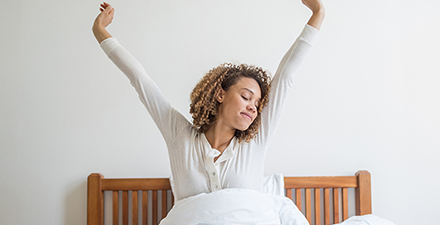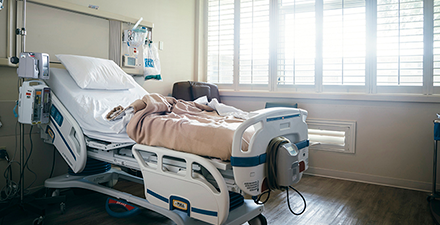Many older adults are not be getting the physical activity they need.
Lack of physical activity can lead to loss of muscle strength at a rate of around 12% a week! Research published in the Journal of Physiology shows that just two weeks of inactivity can cause a loss of strength in older adults that can be difficult to regain.
On the other hand, physical activity and exercise can prevent this decline. According to a study in Medicine and Science in Sports and Exercise, physical activity and exercise also offer many benefits for older adults. These benefits include improving or delaying the loss of physical function and movement and reducing the risk of fall-rated injuries.
Physical activity improves quality of life and:
- Slows the physical changes due to aging.
- Optimizes body composition.
- Supports mental and cognitive health.
- Increases life span.
- Reduces the risk for falls that can result in injury, hospital stays, or even death.
- Can help lower the risk of developing chronic diseases.
- Helps people who have chronic disease manage their health.
How to Stay Healthy and Strong at Home
According to the Department of Health and Human Services guidelines, adults aged 65 and older should perform both aerobic and muscle-strengthening activities every week.
Aerobic Activities
Aerobic activity can include:
- Brisk walking.
- Marching in place.
- Taking stairs repeatedly.
- Any activity that causes your heart to beat faster than usual.
HHS recommends that adults aged 65 and older do aerobic activities for at least one of the following amounts and intensities:
- 30 minutes on five days a week at a moderate intensity.
- 20 minutes on three days a week at a vigorous intensity.
An easy way to gauge your intensity is with the "Talk Test." When doing an activity at a moderate intensity, you should only be able to say one sentence before needing to take another breath. When performing an activity at a vigorous intensity, you should have difficulty with saying even a short phrase before taking another breath.
Strengthening Activities
Individuals should perform muscle-strengthening activities at least two days a week. Doing total-body exercises can help build strength and save time (see video demonstrations). For strengthening exercises, use dumbbells, resistance bands, household items, or your body weight.
Rating how you feel while doing your physical activity or exercises on a scale (like the Borg Rating of Perceived Exertion) can help tell you how hard you should be working. Think of a simple scale from one to 10 (where one equals no exertion, five equals somewhat difficult exertion, and 10 is max exertion or exhaustion). With this scale in mind, you should try to exercise at the following levels:
- Beginner exercisers: Try to achieve a level of exercise difficulty from five (somewhat difficult) to six (difficult).
- Regular exercisers who feel your routine is very easy: Exercise at a level between seven (hard) and 8 (very hard). Ensuring that the exercises are challenging will also ensure that you'll get stronger.
What Exercises Should I Be Doing?
Any exercise is better than no exercise, but the right kind of resistance exercises can improve bone density and function, as noted in a study in the Journal of Bone and Mineral Research.
Below are three routines provided by physical therapists for older adults based on walking ability that can keep you healthy and strong at home. Watch the video that applies to you.
Note: If exercising is new to you, expect a little soreness 24-48 hours after doing this routine. This is normal and expected, and will go away relatively quickly.
Caution: If you experience sharp or severe pain while doing any of these exercises, or have any questions, consult a physical therapist.
Exercises — For Older Adults Using a Walker
Set a timer for 10 minutes and repeat the following routine as many times as possible until time is up.
Modified Squat/Sit to Stands
- Sit on a stable, firm chair or surface with back support and your walker in front of you. Place your feet shoulder-width apart.
- Push through the ground with your feet and stand up tall.
- Put your hands on the chair and lower yourself to the seated position as slowly as possible. If you feel confident, try to sit and stand without using your hands.
- Repeat 10 times.
Modified Deadlift
- Stand with your hands on your walker in front of a stable chair.
- Make an "L" shape with your body and hinge your hips backward with your knees slightly bent.
- Squeeze your glutes (buttocks muscles) as you return to standing up tall.
- Repeat 10 times.
Elevated Pushup
- Stand a little more than arm's length away from a kitchen counter or other sturdy elevated surface.
- Place your palms on the counter's edge, shoulder-width apart with your elbows straight and your weight on the balls of your feet.
- Keeping your whole body in line, and your elbows tucked close to your rib cage, lower yourself toward the counter while you tighten the muscles of your behind, belly, and thighs. Push into and away from the counter, keeping your back flat to return to the starting position.
- Repeat 10 times.
Walking
- Find a clear walkway, such as a long hallway.
- Walk at a pace that you consider "moderately difficult to difficult" for 20 steps.
- Take big steps and stay close to your walker.
- Repeat several times and throughout the day.
Exercises — For Older Adults Using a Cane
Set a timer for 10 minutes and repeat the following routine as many times as possible until time is up:
Squat/Sit to Stand
- Sit on a stable, firm chair or surface with back support and place your feet shoulder-width apart.
- Push through the ground with your feet and stand up tall.
- Slowly lower yourself to the seated position (you can use your hands on the chair if needed).
- Repeat 10 times.
Modified Deadlift
- Hold your cane in both hands horizontally (parallel to the ground) and stand with your back to a stable chair, as if you were going to sit down.
- Keeping a flat back, your cane flush to your body, and your knees slightly bent for the entire movement, hinge your hips backward, as you lower your cane to just below your knees. Note: You can stop above your knees if you feel it is too difficult to go further.
- Squeeze your glutes (buttocks muscles) and think of pushing the ground away as you return to standing up tall.
- Repeat 10 times.
Elevated Pushup
- Stand a little more than arm's length away from a kitchen counter or other sturdy elevated surface.
- Place your palms on the counter's edge, shoulder-width apart, with your elbows straight and your weight on the balls of your feet.
- Keeping your whole body in line, and your elbows tucked close to your rib cage, lower yourself toward the counter while you tighten the muscles of your behind, belly, and thighs.
- Push into and away from the counter, keeping your back flat to return to the starting position.
- Repeat 10 times.
Walk
- Find a clear walkway, such as a long hallway.
- Walk at a pace that you consider "moderately difficult to difficult" for 20 steps.
- Repeat several times and throughout the day.
Exercises — For Older Adults Who Walk Without Assistance
Set a timer for 10 minutes and repeat the following routine as many times as possible:
Modified Squat
- Stand with your back to a firm chair or surface with back support and place your feet shoulder-width apart.
- Slowly lower yourself toward the surface with control and touch your bottom briefly to the sitting surface without sitting all the way down. Note: Make sure to keep your feet grounded to the floor and your knees tracking behind your toes as you lower yourself.
- Push through the ground with your feet as you return to standing up tall.
- Repeat 10 times.
Modified Deadlift
- Choose a weighted object (preferably a dumbbell) that you can easily hold on to. A one- or two-liter bottle of soda, stockpot, or weighted laundry basket are also good options. Note: The weight should be heavy enough so that your last repetition in every round feels “moderately difficult to difficult.”
- Keeping a flat back, your weighted object flush to your body, and your knees slightly bent for the entire movement, hinge your hips backward as you lower the weight to your knees. Note: Think of closing a car door with your butt. You should feel your hamstrings (the muscles on the back of your thighs) working.
- Squeeze your glutes (buttocks muscles) and think of pushing the ground away as you return to stand tall to finish the movement.
Modified Pushup
- Stand a little more than arm's length away from a kitchen counter or other sturdy elevated surface.
- Place your palms on the counter's edge, shoulder-width apart, with your elbows straight and your weight on the balls of your feet.
- Keeping your whole body in line, and your elbows tucked close to your rib cage, lower yourself toward the counter while you tighten the muscles of your behind, belly, and thighs.
- Push into and away from the counter, keeping your back flat to return to the starting position.
- Repeat 10 times.
Walk
- Find a clear walkway, such as a long hallway.
- Walk at a pace that you consider "moderately difficult to difficult" for 20 steps.
- Let your arms swing naturally and be confident.
- Repeat several times and throughout the day.
Physical therapists are movement experts who improve quality of life through hands-on care, patient education, and prescribed movement. If you or your loved one have difficulty with any of these exercises, contact a physical therapist to get an evaluation and treatment that’s specific to you. To find a physical therapist in your area, visit Find a PT.
This article was submitted by Kylie E. Roberts, SPT, in memory of her grandmother, who died due to COVID-19. The Academy of Geriatric Physical Therapy contributed to this resource.
Videos courtesy of Alex Germano, PT, DPT, board-certified clinical specialist in geriatric physical therapy, and Julie Brauer, PT, DPT, who both have earned a certificate in the modern management of older adults.


